Introduction
Attachment is the strong, long lasting bond that develops between a baby and his or her primary caregiver. The caregiver can be a parent or another type of primary carer, for example, a grandparent or foster carer.
The importance of a secure attachment bond to a child’s physical, intellectual, emotional and social development is widely recognised. Secure attachment bonds ensure that a child feels safe, secure and calm enough to experience the optimal development of his or her brain. Feelings of safety result in eagerness to learn, healthy self-awareness, trust, and empathy.
An insecure attachment bond prevents a child’s developing brain from organising itself in the best ways. Insecure attachment can inhibit emotional, mental, and physical development, leading to learning difficulties and problems with forming relationships in later life.
In seeking to explore visitors to our website’s understanding of child attachment, Relationships Australia’s July online survey asked respondents questions about their knowledge, help seeking behaviour and openness to attending services targeted toward improving parent-child attachment.
Previous research finds that…
- When babies develop a secure attachment bond, they are better able to:
- Develop fulfilling intimate relationships
- Maintain emotional balance
- Feel confident and good about themselves
- Enjoy being with others
- Rebound from disappointment and loss
- Share their feelings and seek support
- Severe attachment disorders in children have been observed in up to 80% of high risk families (abuse and neglect, poverty, substance abuse, domestic violence, history of maltreatment in parents’ childhood, depression and other psychological disorders in parents)
Results
More than 1,900 people responded to the Relationships Australia online survey in July 2016, with more than three-quarters of survey respondents (77%) identifying as female.
As was the case for last month’s survey, more females than males responded in every age group (see figure 1 below). Eighty-three per cent of survey respondents were aged between 20‑59 years, with just under two-thirds (60%) of responses contributed by women aged between 30-39 years (inclusive).
The demographic profile of survey respondents remains consistent with our experience of the groups of people that would be accessing the Relationships Australia website, noting a small increase in the proportion of younger people answering this month’s survey.
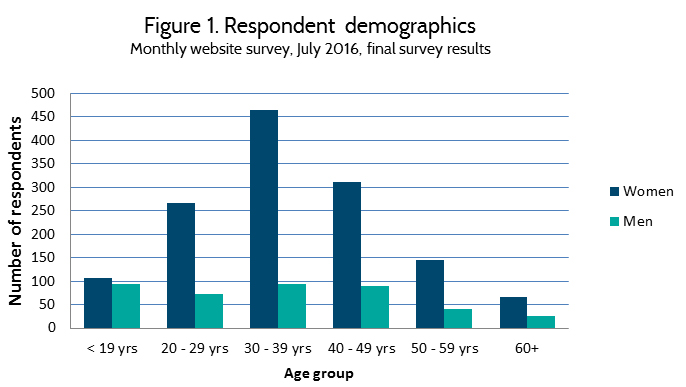
There were small but significant differences between the responses of men and women (figure 2). The majority of men and women survey respondents reported that they always or sometimes knew how to respond to a baby crying. Women were more likely to report that they always knew how to respond to a baby crying (56%) than men (54%).
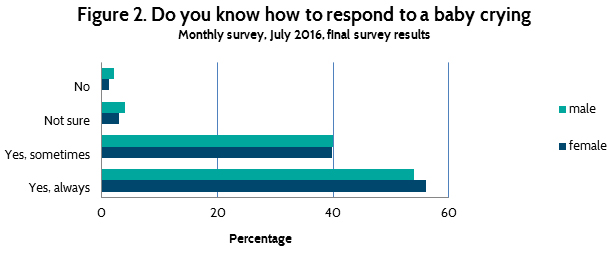
A significant majority of men and women reported that they knew about secure attachment (figure 3). Women survey respondents were more likely (84%) than men (78%) to report that they knew how to create a secure attachment between a parent and child.
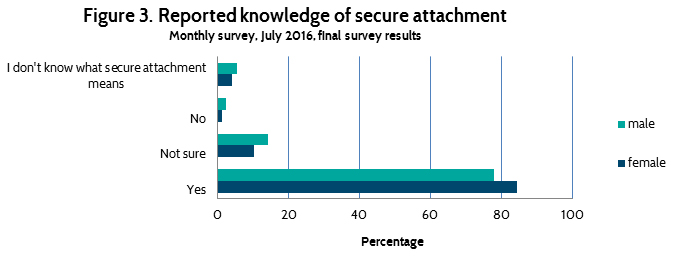
Just under 90 per cent of survey respondents indicated their willingness to attend a course that would help them understand their baby better. Men were more likely to be unwilling to attend a course (12%), or to elect a course that went for more than 4 sessions (31%). Women who reported a willingness to attend a course to help them understand their baby better were more likely to prefer a course length of 1‑2 sessions (32%) or 3-4 sessions (22%).
Survey respondents were more likely to prefer shorter courses when they had children aged less than 18 years, while longer courses were preferred by people with a youngest child aged over 18 years (figure 4). Similar results were found when survey respondents were asked about their willingness to attend a course designed for parenting children of different ages to help them understand their child as they grow.
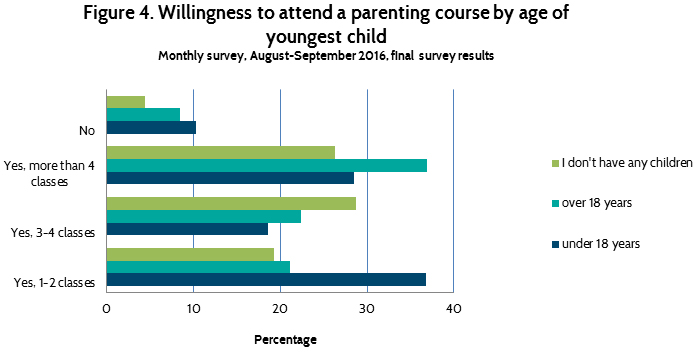
Finally, survey respondents were asked whether they would know where to go to for help if they were worried about their relationship with their baby or child.
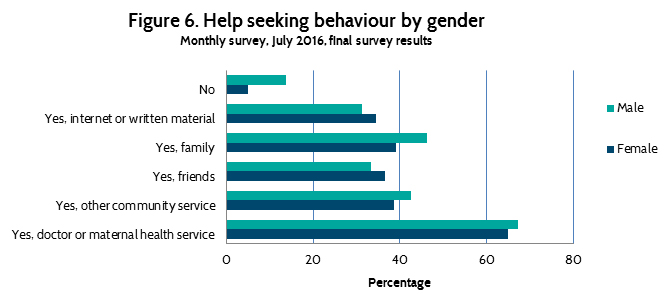
A substantial majority of men and women reported that they would seek help from their doctor, maternal health service, or other community service. Family, friends or the internet/written material were the next preferred sources of help. Just under 15 per cent of men and 5 per cent of women reported that they would not know where to go for help if they were worried about their relationship with their baby or child.
References
Maier, H. W. Development Group Care of Children and Youth. New York: Haworth Press. p22, available at http://www.cyc-net.org/reference/refs-attachmentdisorders.html
National Framework for Protecting Australia’s Children 2009–2020, available at https://www.dss.gov.au/our-responsibilities/families-and-children/publications-articles/protecting-children-is-everyones-business
Second three-year action plan, 2012-2015, Protecting Children is Everyone’s Business,
